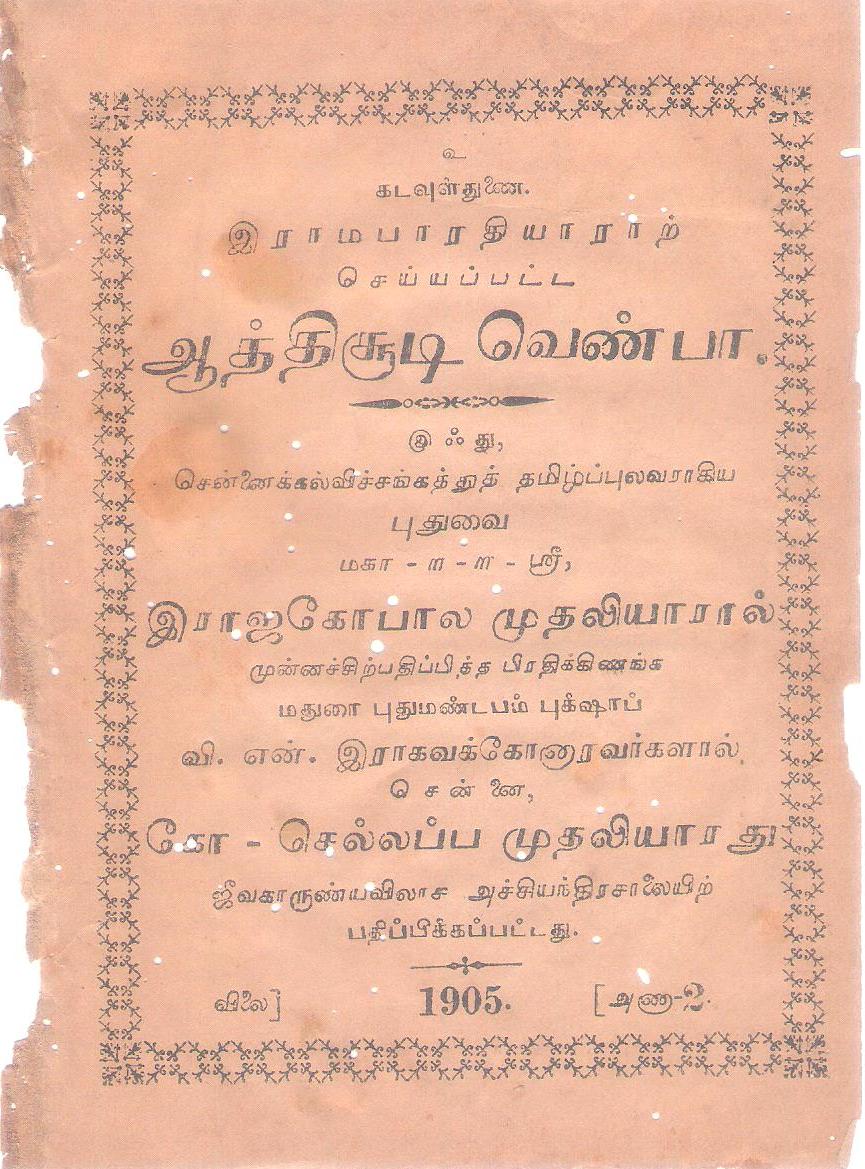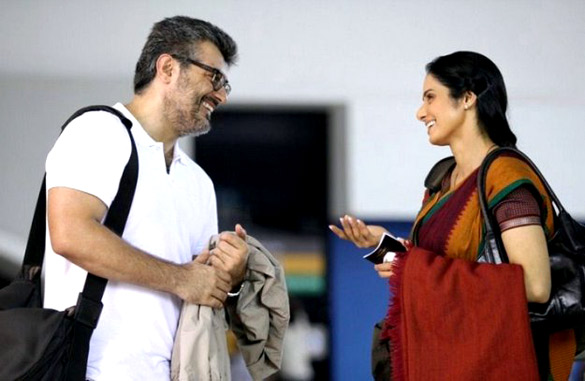|
Venpa
Venpa or Venba ('' வெண்பா'' in Tamil) is a form of classical Tamil poetry. Classical Tamil poetry has been classified based upon the rules of metric prosody. Such rules form a context-free grammar. Every venba consists of between two and twelve lines. The venpa meter is used in songs of the types neṭu veṇ pāṭṭu ('long song in venpa meter'), kuṟu veṇ pāṭṭu 'short song in venpa meter', kaikkiḷai "one-sided love," and paripāṭṭu 'song that is quite accommodative' and in satirical compositions (aṅkatac ceyyuḷ). Popular books written in venba style # All 1330 couplets from the Thirukkural, composed by Thiruvalluvar, are examples of venba. Tirukkural comes under a sub-category of venba called Kural venba, wherein each kural or couplet has only two lines. # Nala venba 1 is another classical work written in venba style. # Niti venba 2 is another venba style book that preaches values. # Acharakkovai 3 is another venba style book that preaches ... [...More Info...] [...Related Items...] OR: [Wikipedia] [Google] [Baidu] |
Kural Venba
The Kural is one of the most important forms of classical Tamil language poetry. It is a very short Poetry#Form in poetry, poetic form being an independent couplet complete in 2 lines, the first line consisting of 4 words and the second line consisting of 3. As one of the five types of Venpa stanza, it must also conform to the grammar for Venpa, the most difficult and the most highly esteemed of stanzaic structures in classical Tamil literature. The ''Tirukkuṛaḷ'' by Tiruvalluvar, one of the greatest philosophical works in Tamil, is a typical example. Structure Prosodic background The Tamil conception of metrical structure includes elements that appear in no other major prosodic system. This discussion is presented in terms of syllables, feet, and lines (although syllables are not explicitly present in Tamil prosodic theory). Similarly to classical Prosody (Latin), Latin, Prosody (Greek), Greek, and Sanskrit prosody, a syllable is long if its vowel is (1) long (including di ... [...More Info...] [...Related Items...] OR: [Wikipedia] [Google] [Baidu] |
Poetry
Poetry (from the Greek language, Greek word ''poiesis'', "making") is a form of literature, literary art that uses aesthetics, aesthetic and often rhythmic qualities of language to evoke meaning (linguistics), meanings in addition to, or in place of, Denotation, literal or surface-level meanings. Any particular instance of poetry is called a poem and is written by a poet. Poets use a variety of techniques called poetic devices, such as assonance, alliteration, Phonaesthetics#Euphony and cacophony, euphony and cacophony, onomatopoeia, rhythm (via metre (poetry), metre), and sound symbolism, to produce musical or other artistic effects. They also frequently organize these effects into :Poetic forms, poetic structures, which may be strict or loose, conventional or invented by the poet. Poetic structures vary dramatically by language and cultural convention, but they often use Metre (poetry), rhythmic metre (patterns of syllable stress or syllable weight, syllable (mora) weight ... [...More Info...] [...Related Items...] OR: [Wikipedia] [Google] [Baidu] |
Syllable
A syllable is a basic unit of organization within a sequence of speech sounds, such as within a word, typically defined by linguists as a ''nucleus'' (most often a vowel) with optional sounds before or after that nucleus (''margins'', which are most often consonants). In phonology and studies of languages, syllables are often considered the "building blocks" of words. They can influence the rhythm of a language, its prosody, its poetic metre; properties such as stress, tone and reduplication operate on syllables and their parts. Speech can usually be divided up into a whole number of syllables: for example, the word ''ignite'' is made of two syllables: ''ig'' and ''nite''. Most languages of the world use relatively simple syllable structures that often alternate between vowels and consonants. Despite being present in virtually all human languages, syllables still have no precise definition that is valid for all known languages. A common criterion for finding syllable bound ... [...More Info...] [...Related Items...] OR: [Wikipedia] [Google] [Baidu] |
George Uglow Pope
George Uglow Pope (24 April 1820 – 11 February 1908), or G. U. Pope, was an Anglican Christian missionary and Tamil scholar who spent 40 years in Tamil Nadu and translated many Tamil texts into English. His popular translations included those of the Tirukkural and Thiruvasagam. He later took to teaching, running his own school in Ootacamund for while and then moving to head the Bishop Cotton Boys' School in Bangalore and after returning to England worked as a Lecturer at Balliol College, Oxford. A statue on the Chennai beach recognizes him for his contribution to the understanding and promotion of the Tamil language. Biography George Uglow Pope was born on 24 April 1820 in Bedeque, Prince Edward Island in Canada. His father was John Pope (1791–1863), of Padstow, Cornwall, a merchant who became a missionary, who emigrated to Prince Edward Island in 1818, and Catherine Uglow (1797–1867), of Stratton, north Cornwall. The family moved to Nova Scotia, St. Vinc ... [...More Info...] [...Related Items...] OR: [Wikipedia] [Google] [Baidu] |
Tamil Grammar
Tamil may refer to: People, culture and language * Tamils, an ethno-linguistic group native to India, Sri Lanka, and some other parts of Asia **Sri Lankan Tamils, Tamil people native to Sri Lanka ** Myanmar or Burmese Tamils, Tamil people of Indian origin settled in Burma/Myanmar primarily during the British period ** Tamil Malaysians, Tamil people of Indian origin settled to Malaysia ** Singapore Tamils, Tamil people of Indian origin settled in Singapore ** Tamil diaspora, descendants of Tamil immigrants living outside of India and Sri Lanka * Tamil language, the native language of the Tamils * Tamiloid languages, Dravidian languages related to Tamil, spoken in India * Tamil script, the writing system of the Tamil language ** Tamil (Unicode block), a block of Tamil characters in Unicode * Tamil dialects, referencing geographical variations in speech * Tamil culture, culture of the Tamil people * Tamil cuisine, cuisine of the Tamil people * Tamil cinema (other) **Tamil ... [...More Info...] [...Related Items...] OR: [Wikipedia] [Google] [Baidu] |
Extended Backus–Naur Form
Extension, extend or extended may refer to: Mathematics Logic or set theory * Axiom of extensionality * Extensible cardinal * Extension (model theory) * Extension (proof theory) * Extension (predicate logic), the set of tuples of values that satisfy the predicate * Extension (semantics), the set of things to which a property applies * Extension (simplicial set) * Extension by definitions * Extensional definition, a definition that enumerates every individual a term applies to * Extensionality Other uses * Extension of a function, defined on a larger domain * Extension of a polyhedron, in geometry * Extension of a line segment (finite) into an infinite line (e.g., extended base) * Exterior algebra, Grassmann's theory of extension, in geometry * Field extension, in Galois theory * Group extension, in abstract algebra and homological algebra * Homotopy extension property, in topology * Kolmogorov extension theorem, in probability theory * Linear extension, in order ... [...More Info...] [...Related Items...] OR: [Wikipedia] [Google] [Baidu] |
Backus–Naur Form
In computer science, Backus–Naur form (BNF, pronounced ), also known as Backus normal form, is a notation system for defining the Syntax (programming languages), syntax of Programming language, programming languages and other Formal language, formal languages, developed by John Backus and Peter Naur. It is a metasyntax for Context-free grammar, context-free grammars, providing a precise way to outline the rules of a language's structure. It has been widely used in official specifications, manuals, and textbooks on programming language theory, as well as to describe Document format, document formats, Instruction set, instruction sets, and Communication protocol, communication protocols. Over time, variations such as extended Backus–Naur form (EBNF) and augmented Backus–Naur form (ABNF) have emerged, building on the original framework with added features. Structure BNF specifications outline how symbols are combined to form syntactically valid sequences. Each BNF consists of t ... [...More Info...] [...Related Items...] OR: [Wikipedia] [Google] [Baidu] |
Juxtaposition (literary)
Juxtaposition is an act or instance of placing two opposing elements close together or side by side. This is often done in order to compare/contrast the two, to show similarities or differences, etc. Speech Juxtaposition in literary terms is the showing contrast by concepts placed side by side. An example of juxtaposition are the quotes "Ask not what your country can do for you; ask what you can do for your country", and "Let us never negotiate out of fear, but let us never fear to negotiate", both by John F. Kennedy, who particularly liked juxtaposition as a rhetorical device. Jean Piaget specifically contrasts juxtaposition in various fields from syncretism, arguing that "juxtaposition and syncretism are in antithesis, syncretism being the predominance of the whole over the details, juxtaposition that of the details over the whole". Piaget writes: In grammar, juxtaposition refers to the absence of linking elements in a group of words that are listed together. Thus, where E ... [...More Info...] [...Related Items...] OR: [Wikipedia] [Google] [Baidu] |
Thalai(tamil Poetry)
Ajith Kumar Subramaniam (born 1 May 1971) is an Indian actor who works predominantly in Tamil cinema. To date, he has starred in over 63 films, and won four Vijay Awards, three Cinema Express Awards, three Filmfare Awards South and three Tamil Nadu State Film Awards. In addition to his acting career, Ajith is also an occasional racing driver and participated in the MRF Racing series (2010) and having competed in circuits around India in places such as Mumbai, Chennai and Delhi. He is one among very few Indians to race in the international arena and in Formula championships. Based on the annual earnings of Indian celebrities, he was included in the ''Forbes India'' Celebrity 100 list three times. Ajith began his career with a small role in the 1990 Tamil romantic drama ''En Veedu En Kanavar''. After his success in ''Rajavin Parvaiyile'', his first major breakthrough was ''Aasai'' (1995), Ajith established himself as a romantic hero with ''Kadhal Kottai'' (1996), ''Kaadhal Man ... [...More Info...] [...Related Items...] OR: [Wikipedia] [Google] [Baidu] |






